Central Florida Storm Preparation: Unique Considerations for Inland Properties
- The Innocent Law Firm
- Aug 25
- 2 min read
While coastal properties often receive the most attention during hurricane season, Central Florida homes face their own unique risks and preparation challenges.

Specific Risks for Central Florida Homes
Central Florida's inland location creates distinctive storm-related concerns:
Tornado Risk:
Right-front quadrant of hurricanes produces highest tornado threat
Central Florida historically sees more hurricane-spawned tornadoes than coastal regions
Mobile homes and manufactured housing face amplified dangers
Flooding from Saturated Ground:
Clay soil common in Central Florida retains water longer
Multiple rain bands can lead to flash flooding far from the coast
Areas near lakes and retention ponds face unique risks
Tree Damage:
Sand pine and water oak species common in Central Florida are particularly vulnerable
Saturated ground reduces root stability
Inland properties typically have more tree coverage than coastal homes
Recent Severe Convective Storm Patterns
Central Florida's weather patterns have shown concerning trends:
Increasing frequency of strong thunderstorm clusters
Higher incidence of straight-line wind events exceeding 70 mph
Growth in "training" storm systems that repeatedly affect the same areas
Rising nighttime storm activity, which poses elevated danger
Longer-duration rainfall events contributing to inland flooding
These patterns require specific preparation strategies for Central Florida homeowners.
Evacuation Planning Guidelines
While coastal evacuation receives more attention, Central Florida residents should have clear plans:
When to Stay:
Your home is not in a flood-prone area
Your home was built after 2002 to stronger building codes
You don't rely on electricity for medical equipment
You have adequate supplies for 7+ days without power
When to Consider Evacuation:
You live in a manufactured or mobile home
Your home is near water bodies that may flood
Your property has large trees close to the structure
You have medical needs requiring electricity
Evacuation Destination Planning:
Identify multiple potential destinations in different directions
Consider inland hotels in North Florida or Georgia
Research county-designated public shelters (including pet-friendly options)
Establish meet-up protocols if family members are separated
Central Florida homeowners face unique challenges during storm season. Contact Innocent Law Firm for guidance on insurance coverage specific to inland Florida property risks.
⚠️ Disclaimer: This information is for educational purposes only and does not create an attorney-client relationship.




Comments